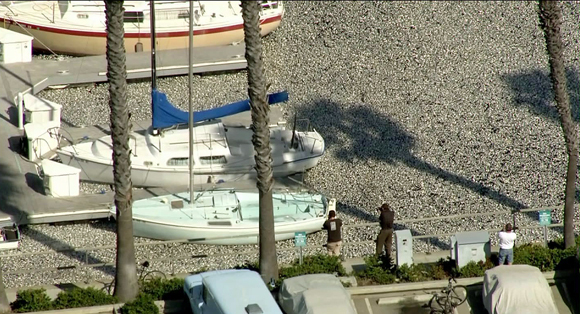
Heal the Bay, one of Southern California's leading ocean advocates, is looking for volunteers to help clean up millions of dead fish that washed up in King Harbor near Redondo Beach on Tuesday.
City public works crews cleaned up 35 tons of fish with skimmers and bulldozers on Tuesday, but much more work remains to be done.
The dead fish, mostly sardines along with anchovies and mackerel, floated up to the surface from the ocean floor.
About 200 city workers and 75 volunteers are working to get the fish out of the harbor. Redondo Beach officials estimate that the clean-up will cost at least $100,000.
Volunteers are working daily from 9 a.m. to 6 p.m.. "No experience or supplies are required -- only enthusiasm," Heal the Bay said in a statement on their website Wednesday.
Heal the Bay also said they are analyzing ocean conditions along with the Redondo Beach SEA Laboratory and the University of Southern California.
"It's critical that all the dead fish are removed within the next couple of days to prevent an even worse problem," the statement said.
Officials said there is layer of fish about 12 to 18 inches thick covering the bottom of the marina, and those fish will wash up to the surface in the days ahead.
Firefighters are using a hose at the bottom of the harbor to try to stir the fish up for a diver to capture.
A sewer vacuum truck is also being used to suck the dead fish from the water with a long plastic hose.
"Now that you have millions and just tons of dead fish, it's going to become a hazmat situation," Sgt. Phil Keenan of the Redondo Beach Police Department told KTLA.
KTLA's Sky5 captured images of the fish completely coating the water's surface in Basins 1 and 2 of the north side of King Harbor on Monday.
Authorities say they do not suspect any sort of poisoning.
"All evidence points to oxygen deprivation as cause of death," says California Department of Fish and Game spokesman Andrew Hughan.
"There is no oil sheen, nor is there a chemical sheen," Hughan said.
Sgt. Keenan said authorities are confident of test results showing that oxygen deprivation caused the massive fish kill because the other part of the sardine school is alive and well in the mouth of the harbor.
"Part of the sardine school is out in the channel of the harbor and they're doing fine," Keenan says.
"For some reason, this large school of sardines got chased into the harbor -- and they died off."
Authorities said that the sardines likely sought calm waters inside the 1,400-vessel marina Monday evening when winds were gusting up to 45 mph and the waters were rough.
"They like to follow each other and it only takes one to come in before the others follow," Brent Scheiwe, program director of the SEA Lab, a hands-on coastal science education center in Redondo Beach, told reporters at a press conference Tuesday.
"The fish found these back areas of the harbor, and then the oxygen depletion would have occurred... If it's rough out there, they will stay here in the waters where it's more sheltered," Scheiwe said.
"There is a risk of the same thing happening tonight," he added.
The harbor's algae may have contributed to the lack of oxygen, and then when the fish started dying, the resulting bacteria also consumed oxygen, Scheiwe said.
Officials are worried that, as the fish decay, bacteria could cause the oxygen levels in the harbor to dip again, killing anything else living in the harbor.
The decay could also boost nutrients in the harbor, leading to an algae bloom that would further deplete oxygen levels.
About the extraordinary number of dead fish, Hughan stated that "while it is unusual, it is not unprecedented. This is natural selection."
Hughan said a necropsy, including a chemical analysis, will be performed on some of the dead fish.



Reader Comments
to our Newsletter